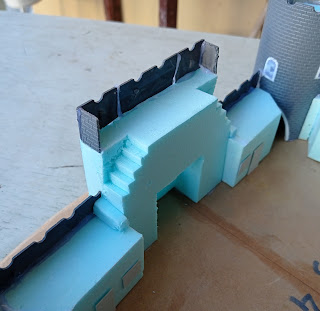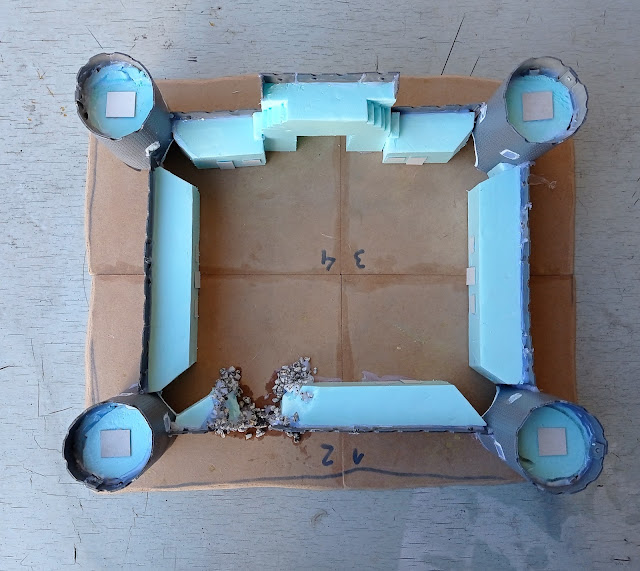Fort Capuzzo was an Italian large structure in the Lybian and Egyptian border built in the 20s to prevent the passage of the Sanussi tribesmen. In WW2 it changed hands several times as it was placed right in the middle of most of the more important offensives from both sides.This fort has been on my plans for some time. I never had the Airfix desert fort nor any nice resin fort and I wanted something with the proper gate of Fort Capuzzo. At the same time the building should be used in other periods of history (more on that later) as it should be something like 40cmX40cm. In fact it ended 40cmX33cm, large enough for a RF battalion to be placed inside.

While looking for Lego Bionicles for my 6 years old boy in a Chinese shop I found these 1 euro tower & walls from the Christmas period. I brought four of them and Capuzzo started to have a shape, at least on my mind.
With the help of the cheap 1 euro models and BlueBoard the construction was an easy affair. All windows were covered with hot glue gun and the whole structure was glued to plywood. Soon I realized that the turrets should have been much shorter but it was too late.
The way other periods of history are possible for this fort is by making the inscription "Ridotta Capuzzo - Amseat- "in a piece of clear plastic...
... and take it out whenever is necessary. The plastic piece just need to sit in some L shaped pin.

The most recognizable part of Capuzzo was its gate and some work was placed on it. Even so I skipped many details for this structure to be as generic as possible.
BlueFoam was used in most structures as its a resistant and easy to work material.
When building something like that you have the choice of building it in a pristine pre-war looks or with some sort of damage.
I went for the second and with the help of some plastic breaking, small pebbles and a hot glue gun something already destroyed was achieved.
The fort was in fact not a single structure but a big number of dwellings and separate buildings and walls.
I kept as simple as possible thinking also about placing some extra buildings inside and outside of the fort.
The true Fort Capuzzo from the sky. The towers were more detached from the walls than in my model and the number of buildings was simply too much to replicate. In the end, a couple of extra desert buildings inside and outside will do the trick.
Next: maybe some WW2 Mediterranean New Zealanders.












Joao, an ingenious solution; you have captured the gateway.
ReplyDeleteCapuzzo is not an easy one to model as the pictures are few and far between, especially pre-destruction. Even then, there are few that show the whole structure and these are usually blurry.
Neil
Thanks Neil. I found some pre-war parade pictures that helped. But yes, the aerial ones are blurry and doesn't help that much. I´ll add a few buildings and walls if wargaming the subject. I also wanted something to be able to place on the table from ancient to modern times in North Africa and that is why the plastic removable name was added.
DeleteGreat model, very useful for other periods, I like your idea of using clear plastic for the name. What does "Amseat" mean in English?
ReplyDeleteThanks Dave. Amseat is the place of construction of Fort Capuzzo. Its also the name of two nearby airfields Amseat I and Amseat II
DeleteGreat work there JP!
ReplyDeleteThanks Steve. This is a useful one even if capuzzian orientated :)
DeleteExcellent work, João!
ReplyDeleteThe tall turrets are nothing that cannot be solved with a hacksaw. :-D
Regards, Chris.
Thanks Chris. Hacksaw or a hammer, both will do :)
Delete